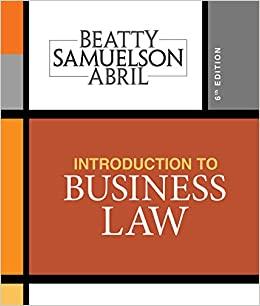Question
11. Countervailing duties are intended to neutralize any unfair advantage that foreign exporters might gain over domestic producers because of foreign: tariffs export subsidies quotas
11. Countervailing duties are intended to neutralize any unfair advantage that foreign exporters might gain over domestic producers because of foreign:
- tariffs
- export subsidies
- quotas
- voluntary export agreements
Answer: Page: 235
12.Which of the following countries spent the most on agricultural subsidies in 2017?
- U.S.
- Japan
- EU
- Korea
Answer: Page: 236, Case Study 9-4
13.Which of the following countries provided the largest agricultural subsidies as a percentage of its agricultural output in 2017?
- U.S.
- Japan
- EU
- Korea
Answer: Page: 236, Case Study 9-4
14. In large developed nations, which sector is most protected by nontariff trade barriers?
- food, beverage and tobacco
- textile and apparel
- wood and wood products
- basic metal industries
Answer: Page: 236, Case Study 9-5
15. According to Case Study 9-5, in which country are nontariff trade barriers most pervasive?
- US
- EU
- Japan
- Canada
Answer: Page: 236, Case Study 9-5
16.Strategic trade and industrial policy is advanced for industrial nations to acquire a comparative advantage in the _____.
- agricultural sector
- manufacturing sector
- high-tech sector
- energy sector
Answer: Page:242
17. Which of the following has benefited from the strategic trade and industry policy?
- Japanese steel industry in the 1950s
- Airbus since the 1970s
- Chinese high-speed trains since 2000s
- All of the above
Answer: Page:242
18._____ raised average import duty in the U.S. to the all-time high.
- The Smoot-Hawley Tariff Act of 1930
- The U.S. Tariff Assignment Act of 1954
- The Trade Agreements Act of 1934
- The Sarbanes-Oxley Act
Answer: Page: 246
19. The Smoot-Hawley Tariff Act of 1930 has often been associated with:
- Reduction in tariffs
- Reduction in non-tariff barriers
- Increasing volume of trade for the US
- Decreasing volume of trade for the US
Answer: Page: 246-247
20. Upon which of these principles was GATT founded?
- Unconditional acceptance of the most-favored-nation principle
- Elimination of nontariff trade restrictions (with a few exceptions)
- Consultation among nations in solving trade disputes within the GATT framework
- All of the above
Answer: Page: 247
21. Which of the following protectionist measures was adopted by the US Congress during the 1950s?
- Peril-point provisions
- Escape clause
- National security clause
- All of the above
Answer: Page: 248
22. The Kennedy Round of trade negotiation succeeded in significantly reducing ________.
- Tariffs on industrial products
- Government subsidies to industrial products
- Tariffs on agricultural products
- Government subsidies to agricultural products
Answer: Page: 248
23. Which of the following countries was NOT cited as one of the most unfair traders under the Omnibus Trade and Competitiveness Act of 1988?
- China
- Japan
- India
- Brazil
Answer: Page: 249
24.The World Trade Organization (WTO) was established by the _____ of multilateral trade negotiations.
- Kennedy Round
- Tokyo Round
- Uruguay Round
- Doha Round
Answer: Page:250-252
25. The Doha Round of trade negotiations failed in 2008 over disagreements over _________.
- Tariffs on industrial products
- Government subsidies to industrial products
- Tariffs on agricultural products
- Government subsidies to agricultural products
Step by Step Solution
There are 3 Steps involved in it
Step: 1

Get Instant Access to Expert-Tailored Solutions
See step-by-step solutions with expert insights and AI powered tools for academic success
Step: 2

Step: 3

Ace Your Homework with AI
Get the answers you need in no time with our AI-driven, step-by-step assistance
Get Started


